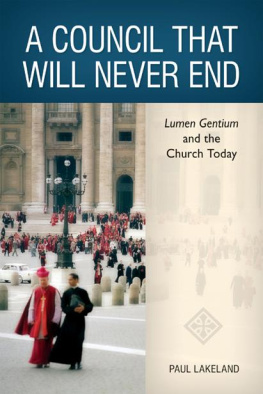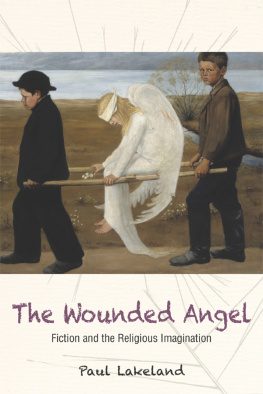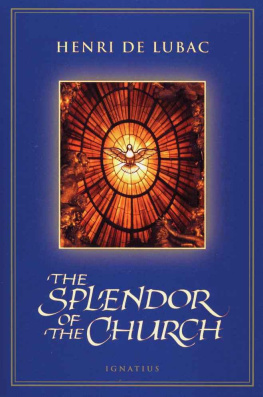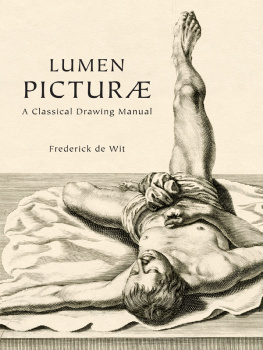Paul Lakeland - A Council That Will Never End: Lumen Gentium and the Church Today
Here you can read online Paul Lakeland - A Council That Will Never End: Lumen Gentium and the Church Today full text of the book (entire story) in english for free. Download pdf and epub, get meaning, cover and reviews about this ebook. City: Collegeville, Minnesota, year: 2013, publisher: Liturgical Press, genre: Religion. Description of the work, (preface) as well as reviews are available. Best literature library LitArk.com created for fans of good reading and offers a wide selection of genres:
Romance novel
Science fiction
Adventure
Detective
Science
History
Home and family
Prose
Art
Politics
Computer
Non-fiction
Religion
Business
Children
Humor
Choose a favorite category and find really read worthwhile books. Enjoy immersion in the world of imagination, feel the emotions of the characters or learn something new for yourself, make an fascinating discovery.
- Book:A Council That Will Never End: Lumen Gentium and the Church Today
- Author:
- Publisher:Liturgical Press
- Genre:
- Year:2013
- City:Collegeville, Minnesota
- Rating:3 / 5
- Favourites:Add to favourites
- Your mark:
- 60
- 1
- 2
- 3
- 4
- 5
A Council That Will Never End: Lumen Gentium and the Church Today: summary, description and annotation
We offer to read an annotation, description, summary or preface (depends on what the author of the book "A Council That Will Never End: Lumen Gentium and the Church Today" wrote himself). If you haven't found the necessary information about the book — write in the comments, we will try to find it.
Paul Lakeland: author's other books
Who wrote A Council That Will Never End: Lumen Gentium and the Church Today? Find out the surname, the name of the author of the book and a list of all author's works by series.
A Council That Will Never End: Lumen Gentium and the Church Today — read online for free the complete book (whole text) full work
Below is the text of the book, divided by pages. System saving the place of the last page read, allows you to conveniently read the book "A Council That Will Never End: Lumen Gentium and the Church Today" online for free, without having to search again every time where you left off. Put a bookmark, and you can go to the page where you finished reading at any time.
Font size:
Interval:
Bookmark:
This volume offers a perceptive reading of one of Vatican IIs most important documents, Lumen Gentium, balancing an appreciation for the documents enduring contributions with an acknowledgment of its inevitable inconsistencies. Combining fresh theological perspectives with a dry wit and a perceptive reading of the state of the Catholic Church today, Lakeland uses Vatican II as a springboard for diagnosing what ails the church today. He concludes with a bracing call for a more humble church focused on its mission in the world.
Richard Gaillardetz
Joseph McCarthy Professor of Catholic Systematic Theology Boston College
This book is a must-read for anyone interested in the challenges of being Catholic today. In this concise, engaging, and delightfully readable volume, Lakeland provides a commentary on Lumen Gentium that sheds light not only on the Second Vatican Council but also on the current situation and the contemporary issues facing the Catholic Church. Even while probing some of Catholicisms most neuralgic debates with his characteristically honest and insightful judgment, Lakelands tone of patient hope and good humor inspires rather than polarizes. I know of no better answer to the question of whether the Second Vatican Council still matters than A Council That Will Never End.
Mary Doak
Associate Professor of Systematic Theology University of San Diego
Paul Lakeland has produced another groundbreaking study which will inspire and energize so many throughout the church and academy alike. In this period of significant anniversaries concerning Vatican II, The Council That Will Never End is a self-consciously forward-looking book that draws on the inspirations of the past in order to serve the church of the future. The focus on Lumen Gentium is intended to bring alive a vision of what the church truly is, can be, and must be. It wrestles with the unfinished business of that document and of the council in general in a refreshingly honest and constructive fashion. This book should be required reading in all courses exploring ecclesiology, recent church history, and ecumenism.
Gerard Mannion
Amaturo Chair in Catholic Studies Georgetown University
Lumen Gentium
and the Church Today
Paul Lakeland

LITURGICAL PRESS
Collegeville, Minnesota
www.litpress.org
A Michael Glazier Book published by Liturgical Press
Cover design by Jodi Hendrickson. Image: Wikimedia Commons: License CC-BY-SA 3.0/ Author: Lothar Wolleh.
Excerpts from documents of the Second Vatican Council are from Vatican Council II: The Basic Sixteen Documents, by Austin Flannery, OP, 1996 (Costello Publishing Company, Inc.). Used with permission.
Scripture texts in this work are taken from the New Revised Standard Version Bible 1989, Division of Christian Education of the National Council of the Churches of Christ in the United States of America. Used by permission. All rights reserved.
2013 by Order of Saint Benedict, Collegeville, Minnesota. All rights reserved. No part of this book may be reproduced in any form, by print, microfilm, microfiche, mechanical recording, photocopying, translation, or by any other means, known or yet unknown, for any purpose except brief quotations in reviews, without the previous written permission of Liturgical Press, Saint Johns Abbey, PO Box 7500, Collegeville, Minnesota 56321-7500. Printed in the United States of America.
The Library of Congress has cataloged the printed edition as follows:
Library of Congress Cataloging-in-Publication Data
Lakeland, Paul, 1946
A council that will never end: Lumen gentium and the church today / Paul Lakeland.
pages cm
A Michael Glazier book.
Includes bibliographical references.
ISBN 978-0-8146-8066-7 ISBN 978-0-8146-8091-9 (ebook)
1. Vatican Council (2nd: 19621965). Constitutio dogmatica de Ecclesia. 2. Church. 3. Catholic ChurchDoctrines. I. Title.
BX1746.L285 2013
262.02dc23
2013018428
This book is dedicated to two of my greatest teachers, Winifred Livesey and Arthur Malone, in gratitude.
It was for a mystical reason that I decided to go to St. Peters this morning: to participate in the grace and the occasion of the Council at its most decisive moment.
Yves Congar, November 21, 1964, the date of the promulgation of Lumen Gentium
T he problem with anniversaries is that they often focus on the past event rather than the present reality. This is less likely to be the case if the anniversary commemorates the beginning of something still very much alive. It is the difference between toasting the hundredth birthday of a favorite aunt and recognizing the anniversary of the end of the First World War. In the first case we focus on the person present in the room, in the second on an event that happened long ago. So as we begin to think about the fifty years that have elapsed since the Second Vatican Councils Constitution on the Church, Lumen Gentium, was ratified by the Council fathers, we need to ask ourselves if it feels more like Aunt Millies birthday party or the bittersweet reverence for a significant but long-past moment in world history. Is Lumen Gentium still with us?
In the chapters that follow we will take for granted that Lumen Gentium is indeed still with us in a variety of ways. As a document, it will always be part of the ecclesial tradition. A thousand years from now it will still be there, and maybe still read. More important, it is still with us in the shape of the changed Church that its teachings led to. How we understand the role of the bishops in the Church, relative to one another, to the bishop of Rome, and to the people they serve, was given new clarity in the document. So too, Lumen Gentium changed how we think about the roles of the laity in the Church and how we think about holiness relative to all sections of the Church. It led directly to a renewed sense of the importance of baptism and it introduced the important idea of the pilgrim Church. Most of all, however, it is still with us in the particular struggles and challenges of our present moment in the history of the Church. It is this presence that will occupy us in this book.
The phrase unfinished business, which I will use frequently in this book, refers to the complex relationship between Lumen Gentium and the tensions in todays Church. The clearest way in which Lumen Gentium remains a living presence in our Church is its implication in the various ecclesial challenges of our day. Lumen Gentium was not always clear and certainly did not always dot every i and cross every t. The ambiguities and the occasional lack of clarity in the text connect directly to many questions in todays Church: the authority of bishops relative to the role of the laity, the degree to which Church authority should or should not be as centralized in Rome as is currently the case, the nuances of an ecclesiology of the People of God and an ecclesiology of communion, and the relationship between the Church and the other great world religions. These and other issues are in play in the tensions in Roman Catholicism today, and it is the relationship between these concerns and the text of Lumen Gentium that we will explore in the pages that follow. It is my conviction that much of the malaise of Roman Catholicism today is to be attributed to ambiguities and lack of clarity in the texts of the Council documents in general and in Lumen Gentium in particular.
In consequence, this recognition of Lumen Gentium is at least as much about the present-day Church
I would like to thank a number of individuals for the help and inspiration they have given me in the present task. My colleagues in the religious studies department at Fairfield University continue to provide the supportive and collegial academic community that makes all our work easier. Among them I have, as always, to single out John Thiel, without whose keen editorial eye over the years I would have been guilty of many infelicities of expression. His invitation to deliver a plenary address at the 2011 annual meeting of the Catholic Theological Society of America was the instigation of much that is to be found in the third and final part of this book. My department chair Nancy Dallavalle, who works closely with me in the field of Catholic studies, has also been very helpfulmore, I am sure, than she realizes. And I must thank in a special way Michael Fahey, SJ, currently scholar-in-residence at Fairfield University, who has carefully read my manuscript and given me the benefit of his enormous erudition with unstinting generosity. Further afield, the members of the New York area theological reading group that spun off from the Nashville-based Workgroup for Constructive Theology have been a remarkable and congenial collection of friends and scholars who model the best kind of academic companionship: Teresa Delgado, Jeannine Hill Fletcher, Elena Procario Foley, Roger Haight, SJ, Brad Hinze, Michele Saracino, and John Thiel. I am also grateful to the leadership of the Catholic Theological Association of Great Britain who invited me to give the plenary address on Lumen Gentium that led me to start thinking about a council as an open-ended event, even as a council that will never end. Obviously, none of these people can be blamed for the conclusions I have come to or the errors I have stubbornly insisted on retaining.
Font size:
Interval:
Bookmark:
Similar books «A Council That Will Never End: Lumen Gentium and the Church Today»
Look at similar books to A Council That Will Never End: Lumen Gentium and the Church Today. We have selected literature similar in name and meaning in the hope of providing readers with more options to find new, interesting, not yet read works.
Discussion, reviews of the book A Council That Will Never End: Lumen Gentium and the Church Today and just readers' own opinions. Leave your comments, write what you think about the work, its meaning or the main characters. Specify what exactly you liked and what you didn't like, and why you think so.

